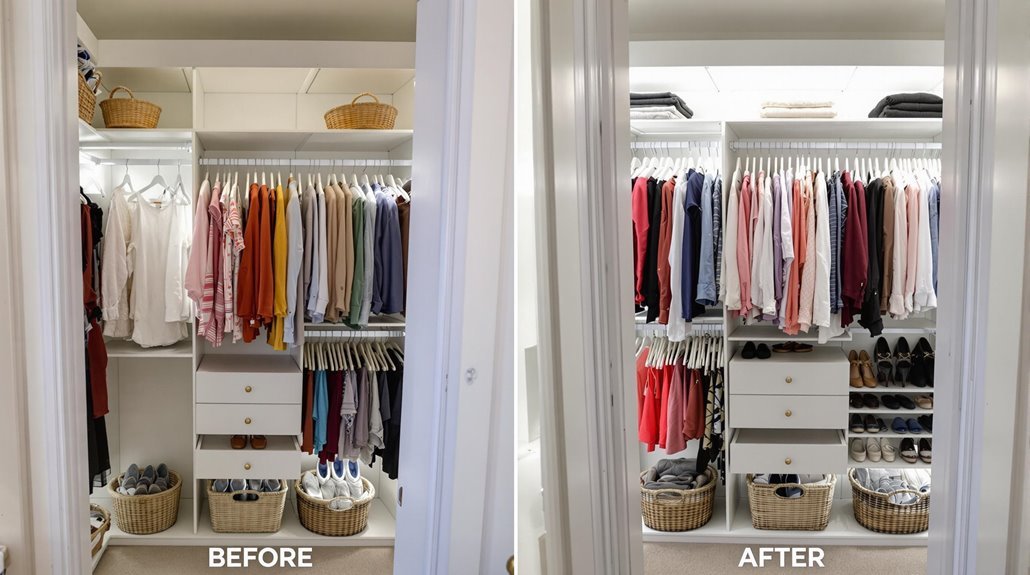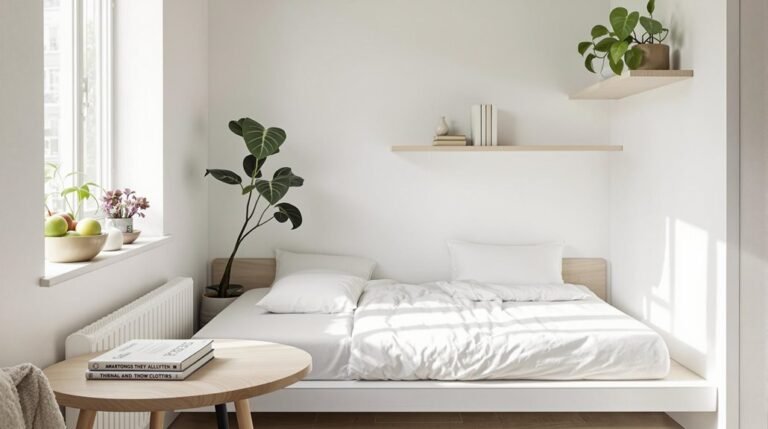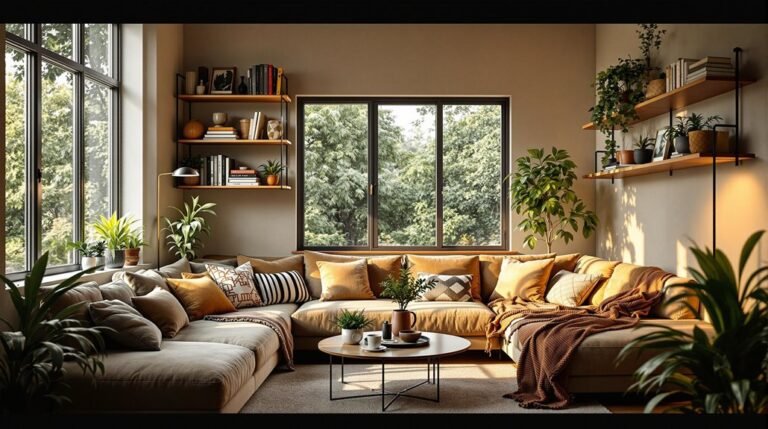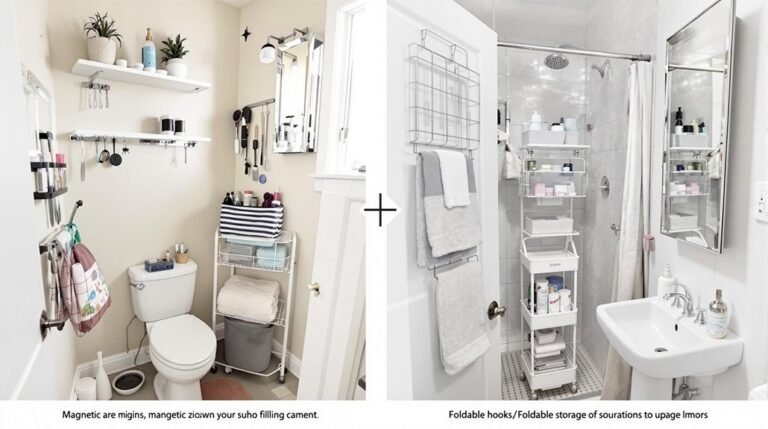Small closets present significant organizational challenges for homeowners and apartment dwellers alike. With limited square footage, these spaces quickly become cluttered, making daily routines frustrating and inefficient. However, strategic planning transforms even the tiniest closet into a streamlined storage solution. Several proven techniques exist to maximize every inch of available space while maintaining accessibility to frequently used items. The difference between a cramped closet and a functional one often lies in thoughtful organization rather than physical dimensions.
Key Takeaways
- Implement vertical organization with multi-tiered shelving systems to maximize space and create distinct storage zones.
- Ruthlessly declutter using methods like the 90-90 rule and establish “one in, one out” policies for clothes.
- Utilize door and wall spaces with organizers, hidden hooks, and sliding racks for additional storage opportunities.
- Invest in clear, stackable storage containers with compartments to increase visibility and organization.
- Measure your closet precisely before implementing any solutions to ensure optimal space utilization.
Assess Your Current Space: Taking Inventory Before You Begin
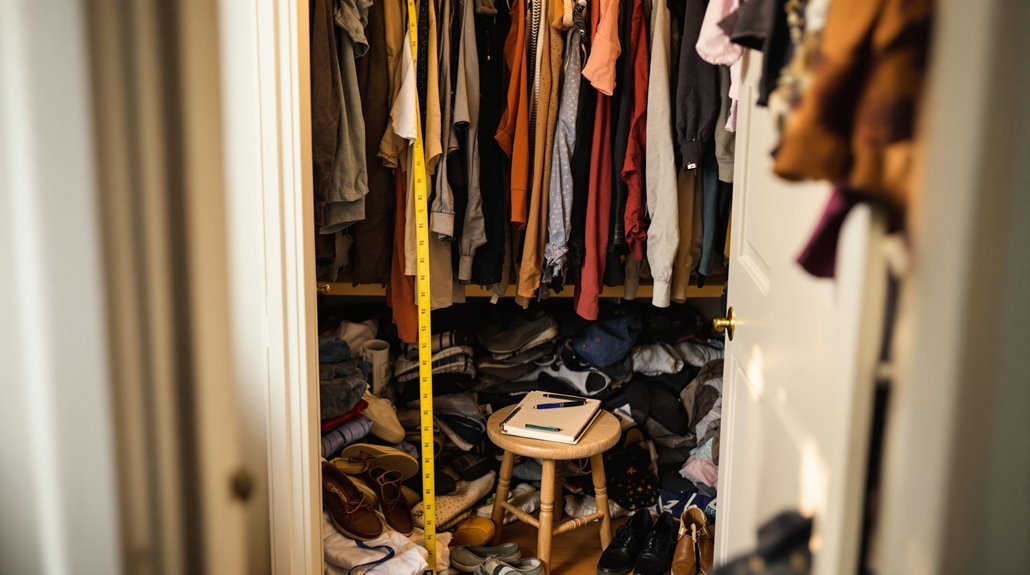
Transforming a tiny closet begins with precise measurement and thorough assessment. Creating a detailed space measurement framework guarantees ideal design solutions that maximize every inch. Using a 12-foot tape measure, record vertical dimensions from floor to ceiling and take horizontal measurements at three different heights to account for wall inconsistencies.
The foundation of small closet success lies in meticulous measurement—your blueprint for maximizing every precious inch of space.
When developing your inventory checklist, document all structural features and obstacles: door swing direction, electrical outlets, ventilation grilles, and fixed cabinetry.
Note ceiling height and identify any soffits or headers above doorways as these affect vertical storage potential. Mark existing hardware like poles or tracks, but exclude these from your measurements to calculate true available space.
This systematic approach reveals opportunities for efficient storage zones and highlights physical constraints that require creative workarounds in your design plan.
Ruthless Decluttering: The Foundation of Closet Expansion
The path to a truly functional tiny closet begins with ruthless decluttering, the essential foundation for any successful space optimization.
Adopting a minimalist mindset requires implementing strict systems that challenge emotional attachment to unworn items. The 90-90 rule provides an objective standard: discard anything unworn for 90 days with no plans to wear it in the next 90.
Time-bound techniques like the one-year test or 20-minute speed rounds create momentum and accountability.
Empty the closet completely to force evaluation of each item’s worthiness. For items with sentimental value, take photographs before donating to preserve memories without sacrificing space.
Implement numerical limits based on laundry cycles and establish a firm “one in, one out” policy.
These practices transform decluttering from a one-time event into a sustainable habit that maintains your newly optimized closet.
Vertical Magic: Doubling Your Storage Capacity
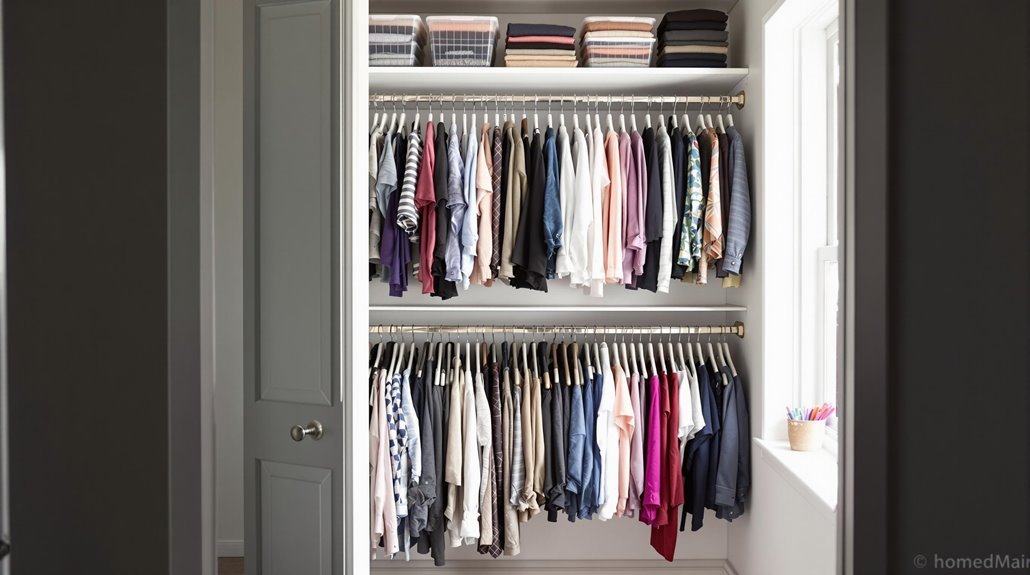
With a decluttered foundation in place, vertical organization emerges as the key strategy for maximizing tiny closet potential.
Shelving units, which dominate 64.1% of the global closet organizer market, offer the most efficient solution to utilize unused vertical space.
Multi-tiered systems transform closets by creating distinct storage zones—placing frequently used items at eye level while relegating seasonal belongings to upper shelves.
Both open and closed vertical shelving options accommodate folded garments, accessories, and shoes, with adjustable heights to customize storage needs.
The modular nature of modern shelving, particularly those crafted from durable MDF, allows for reconfiguration as needs change.
For renters and homeowners alike, dual mounting options provide flexibility, while no-tools installation appeals to those seeking DIY solutions for their space-challenged closets.
Hidden Opportunities: Door and Wall Space Solutions
Every inch matters when tackling tiny closet renovations, especially the overlooked potential of doors and wall spaces.
Door organizers transform unused surfaces into valuable storage compartments, while hidden hooks installed along door edges provide quick-access points for accessories without consuming interior space.
Transform wasted door space into organized storage with slim compartments and discreet edge hooks for accessible accessories without sacrificing valuable closet real estate.
Maximize vertical wall capacity by installing adjustable sliding racks that create dynamic configurations for hanging items.
Recessed installations prevent doors from protruding into walkways while maintaining smooth operation in confined areas. Under door trays cleverly utilize dead space for small items storage.
Consider barn doors for sturdy, space-saving access that doesn’t compromise visibility. Position stacking hangers near door spaces to maximize vertical capacity for lightweight items, and incorporate glass partitions to maintain light flow while separating closet zones without spatial compromise.
Smart Storage Buys: Containers That Make a Difference
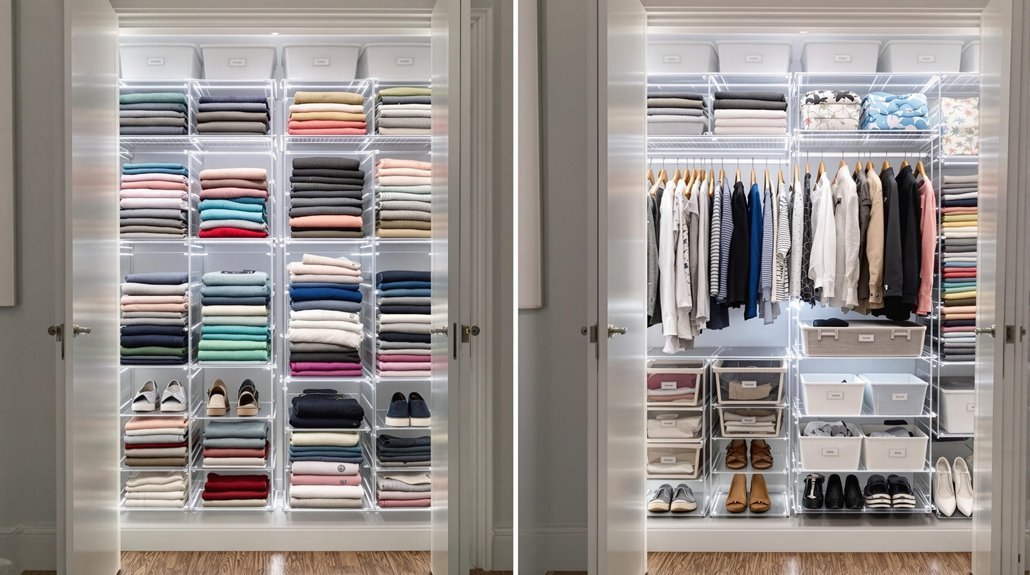
Selecting the right storage containers makes all the difference in transforming a cramped closet into a functional space that maximizes every square inch. Clear containers provide immediate visibility solutions, eliminating time wasted searching for items, while stackable bins utilize vertical space efficiently.
When choosing between transparent plastic bins versus colored options, consider how visibility affects your daily routine.
For thorough organization, compartmentalized storage such as drawer organizers create designated spaces for smaller accessories. Multifunctional organizers, particularly modular cabinets with adjustable shelving, adapt to changing storage needs throughout the seasons.
Under bed storage units offer supplemental space for off-season clothing, freeing valuable closet real estate. When selecting containers, prioritize systems that work together—stackable bins with interchangeable lids and adjustable compartments provide the flexibility tiny closets require to feel exponentially larger.
The Art of Visual Organization: Color Coding and Display Techniques
Visual organization transforms a well-contained closet into a truly efficient system that saves time and reduces decision fatigue.
Begin by categorizing garments by type before implementing color blocking strategies. Arrange items following the extended ROYGBIV spectrum, positioning frequently worn neutrals at eye level for easy access.
For pattern management, either create dedicated zones for multi-colored pieces or assign them to sections based on their dominant hue. Accessory coordination becomes simpler with uniform hangers and clear storage containers that maintain visual consistency throughout your closet.
Advanced display techniques like vertical folding allow you to see all clothing at once, while color-coded dividers create distinct sections.
Consider implementing seasonal rotation, bringing current palette choices forward during appropriate months. These organizational methods not only maximize space but also create a boutique-like experience in even the smallest closet.
Seasonal Rotation Strategies: Managing Clothes Year-Round
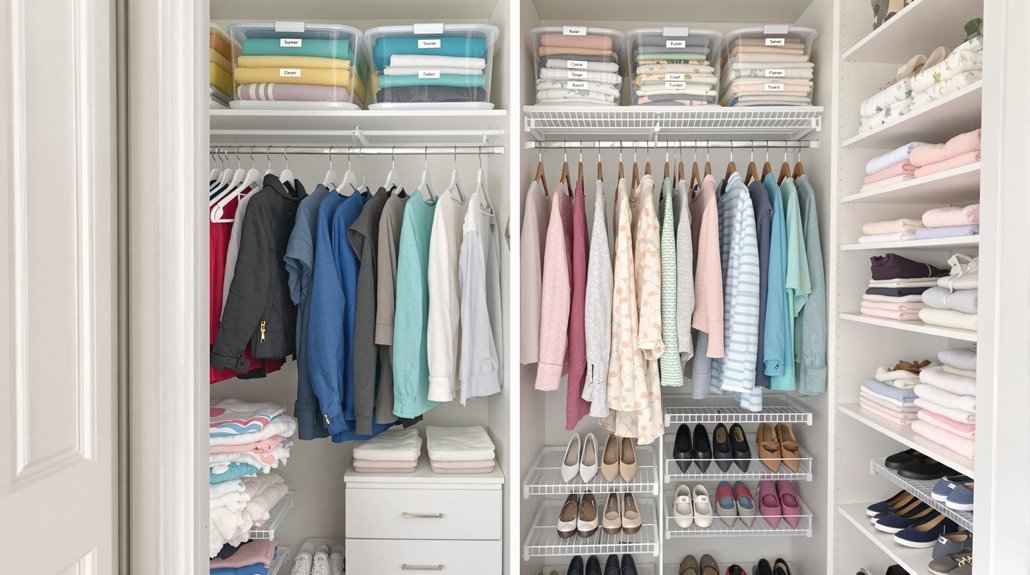
Successful seasonal rotation transforms a cramped closet into a functional, year-round system that adapts to changing weather and lifestyle needs.
Scheduling bi-annual wardrobe swaps during equinoxes creates natural interchange periods, allowing time for assessment and organization of seasonal items.
Proper storage techniques are essential for maintaining a streamlined seasonal wardrobe.
Using breathable, moisture-resistant containers in climate control environments preserves fabric integrity, while clearly labeled storage prevents frustrating searches.
Hidden spaces like under-bed compartments offer perfect solutions for bulky winter coats or summer linens.
Digital tracking systems help manage inventory through photos and location markers, making retrieval efficient.
Implementing a post-rotation audit identifies unnecessary duplicates and highlights genuine wardrobe gaps.
This systematic approach eliminates clutter while ensuring every piece serves a purpose throughout the year.
DIY vs. Professional Systems: Finding Your Perfect Storage Match
Choosing between DIY and professional storage systems requires homeowners to evaluate budget constraints, personal skills, and long-term closet needs.
DIY advantages include significant cost savings ($200-$2,200 versus $1,000-$8,000 for professional systems) and immediate project initiation without scheduling contractors. However, material comparisons reveal that prefabricated options often utilize particleboard that may not offer the long-term durability of custom solutions.
DIY systems deliver dramatic savings and immediate installation, but often sacrifice longevity with less durable materials than professional alternatives.
Professional systems excel in customization benefits, integrating specialized features like motorized rails and built-in lighting that DIY kits typically lack.
Installation timelines vary considerably—professionals complete projects in 4-16 hours, while DIY approaches depend on the homeowner’s experience level.
When conducting a cost analysis, consider that professional drawbacks include higher initial investment but potentially greater space optimization and longevity, particularly in moisture-prone environments.
Frequently Asked Questions
How Do I Maintain My Organized Closet Long-Term?
Maintaining an organized closet requires a consistent seasonal rotation system and adherence to a maintenance checklist.
Homeowners should implement biannual audits in spring and fall, removing unwanted items while reassessing clothing needs.
Quarterly rotations keep frequently used items accessible while storing seasonal pieces in labeled bins.
Setting calendar alerts for maintenance tasks guarantees these routines become habitual, preventing clutter buildup through regular partial declutters focused on high-use zones between major clean-outs.
Can Small Closets Accommodate Specialized Storage for Formal Wear?
Small closets can indeed accommodate formal wear through strategic storage solutions.
Utilizing vertical space with specialized hangers for suits and dresses preserves fabric integrity while maximizing capacity. Acid-free boxes with tissue paper protect beaded gowns and special occasion pieces when folded.
For accessibility, implementing labeled containers and dedicated sections helps maintain organization. Wall-mounted hooks and door organizers create additional storage for formal accessories without consuming valuable floor space.
How Do I Organize Shared Closet Space With a Partner?
Successful closet sharing begins with direct communication strategies about needs and preferences before implementing physical solutions.
Partners should establish designated zones using vertical or horizontal divisions, color-coded storage, and physical dividers.
Maintaining shared space requires regular decluttering sessions and clear protocols for item placement.
When both individuals contribute to organizing decisions and respect boundaries, even limited closet space can function efficiently while preserving relationship harmony.
What’s the Best Solution for Storing Awkwardly-Shaped Accessories?
For awkwardly-shaped accessories, multi-tiered hanging organizers with clear pockets provide visibility while maximizing vertical space.
Drawer dividers with adjustable compartments accommodate oddly-shaped items like belts, scarves, and statement jewelry.
Consider specialized solutions such as rotating lazy Susans for hats or retractable shelves for clutches.
Behind-door storage systems with hooks can display longer pieces while fold-out shelving units work well for items requiring occasional access.
How Can I Make My Closet Smell Fresh Year-Round?
Maintaining a fresh-smelling closet requires a multifaceted approach.
Strategically place scented sachets among clothes and rotate them quarterly for consistent fragrance. Install activated charcoal deodorizer bags to absorb unwanted odors while using high-quality air fresheners designed specifically for confined spaces.
Guarantee proper ventilation by incorporating breathable storage solutions and maintaining humidity below 60%.
Regularly launder stored fabrics completely, even those recently cleaned, to eliminate absorbed odors that develop over time.
Bottom Line
With these strategic techniques, homeowners can transform even the smallest closets into surprisingly efficient storage spaces. The key lies in thoughtful planning, consistent organization, and maximizing every available inch. Whether implementing DIY solutions or investing in professional systems, the rewards of an optimized closet extend beyond mere storage—creating a stress-free morning routine and bringing unexpected spaciousness to compact living environments.
